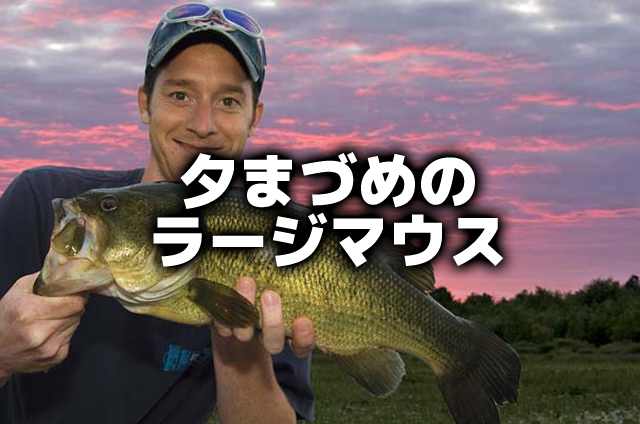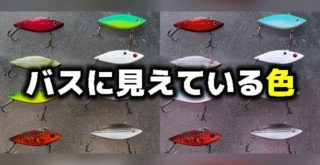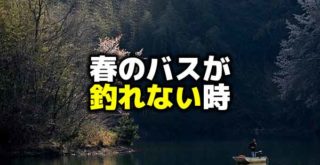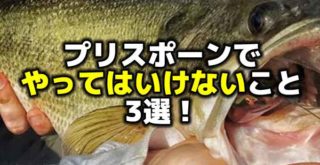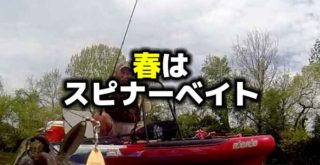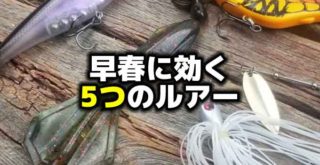バス釣りの敵!?フォールターンオーバーに立ち向かえ!

Photo by World Fishing Network.com
こんにちは!店長の小山です!
本日は海外サイトより、”Bass Fishing Tips: Tackling Turnover Trauma”という記事を引用してご紹介いたします
引用先:worldfishingnetwork.com”Bass Fishing Tips: Tackling Turnover Trauma”By: Keith 'Catfish’ Sutton(海外サイトです)
どうやらこの時期が来てしまったようですね。そうです、フィールドの水質が悪化してしまう「ターンオーバー」の季節です。
皆さんはフォールターンオーバーという現象はお好きでしょうか。
ちょっと話は前後してしまいますが、そもそもフォールターンオーバーとは何だということですが、それは本文中に出てきますので、詳しくは記事本文に譲りますが、結果だけ言うと湖の水質が悪くなってバスの活性が下がってしまって釣れづらくなるという状況を引き起こしてしまう現象なんですよね。
ちなみに私は、フォールターンオーバーが嫌いかというと、そうでもありません。
そもそも、夏が過ぎて気温が下がってくると、バスの動きの気まぐれ度はかなり上がってくると思うんです。シャローにもディープにもいますし、午前中にいっぱいいたバスが午後にはいなくなっていたり、ボイルする場所がちょくちょく変わってしまったり。
そうなんです。そもそもでいいますと私のレベルではターンしていようがいまいがあまり釣れなくなってしまいますので、フォールターンのせいにはできないんです。
ただし、私のレベルでは本当にターンオーバーがの影響で釣れなかったのかどうかもよく分かっていないですとか、私がターンオーバーが好きかどうかにも関わらず、私より高いレベルのアングラーさんの間においては、フォールターンの影響は確かにあると言われています。言われているんです。
この記事は、北アメリカを中心としたルアーフィッシング専門メディア「World Fishing Network」の記事で、フォールターンが起きた場合でも、ターンオーバーのことを理解することでそれを恐れる必要はなくなると言っています。
やはり、私の釣れない原因を本当にターンオーバーのせいにしないために、まずターンオーバーのことをしっかり理解する必要がありそうです。そしてそれをちゃんと理解すれば、もしかしたらレベルアップできるかもしれません。
早速読んでみようと思います。
ターンオーバーとは何ですか?
During summer, many lakes stratify into three distinct layers. These lakes have a layer of cold, poorly oxygenated water on the bottom, and a layer of warm, moderately oxygenated water on top. Because cold water is heavier than warm water (to a certain degree), the warmer water stays on top and colder water sinks to the bottom. In between lies a layer of cool, oxygen-rich water called the “thermocline.” Summer bass are usually found in or near the thermocline because that layer best satisfies their needs for oxygen and water temperature.
In late summer, fall or early winter (the exact time depends largely on the latitude in which the lake lies), cool weather begins lowering the surface water temperature. As the upper layer cools, it becomes heavier and sinks. This action forces the warmer, lighter water below back to the surface. This water subsequently is cooled, just as the previous surface layer was, and descends as it cools. This mixing or “turnover” continues for several weeks until the thermocline disappears and all water in the lake is roughly the same temperature. This mixing effect also replenishes the oxygen in deep water.
The end result is that fish formerly restricted to narrow bands of acceptable oxygen and temperature levels are no longer limited in their movements. Bass that once were barred from dropping into the coolest depths because of low oxygen levels now may roam freely to much deeper water. Likewise, where once fish could not spend extended periods in extreme shallows due to high temperatures and low oxygen levels, after turnover even these areas are acceptable. Bass may now be found deep, shallow or anywhere in between.
Technically, turnover continues until the surface water temperature drops below 39 degrees F. Water is heaviest at this temperature and sinks to the bottom. Cooler water “floats” on top. Therefore, our lakes freeze from the top down, rather than from the bottom up. And this represents the annual end of the turnover process.
夏の間に、多くの湖では水が3つの異なる層に階層化されます。その湖では、底には冷たく酸素が不足した水の層があり、水面近くには暖かく適度に酸素を含んだ水の層があります。冷たい水は暖かい水よりも(ある程度)重いので、暖かい水は上に残り、より冷たい水は下に沈みます。その間には"サーモクライン"と呼ばれる、涼しくて酸素の豊富な水の層があります。その層は酸素と水温のニーズを最も満たすため、夏のバスは通常、サーモクライン内またはサーモクラインの近くにいます。
夏の終わりから秋または冬のはじめ(正確な時期は湖のある地域の緯度によって異なります)、気温が下がると表水温を低下させ始めます。上の層の水が冷えると重くなり、沈みます。この作用により、より暖かく軽い水が表層まで押し上げられます。この水もまた、先の上の層のときと同じように冷却されると沈下します。こうして混じり合うこと、または「ターンオーバー」することは、サーモクラインがなくなり、湖のすべての水がおおよそ同じ温度になるまで、数週間続きます。この混じり合うことによる効果はまた、深い水中の酸素も補充します。
最終的な結果として、そこにいやすい酸素または温度レベルのある層に限定されていた魚たちは、もはやその動きの制限がなくなります。かつて低酸素レベルのために最も冷たい深度に落ちることを嫌っていたバスも、より深いディープレンジに自由に移動することがあります。同様に、これまで魚が高温および低酸素レベルのために極端なシャローで長期間を過ごすことができなかった場合でも、ターンオーバーによってこれらのエリアにいられるようになります。バスはディープ、シャロー、またはその間のどこにでも見つけることができます。
専門的に言えば、表水温が4℃を下回るまでターンオーバーは続きます。水はこの温度で最も重いため底に沈み、今度はより冷たい水が上に浮くようになります。したがって、湖は底から上に向かってではなく、上から凍っていきます。そしてこれが、ターンオーバーの終わりを表しています。
ターンオーバーが起きているかどうかはどのようにして見分けられますか?
The time of year when turnover occurs varies by latitude. While anglers in cooler areas may begin turnover strategies in September, warmer regions may not have turnover until January.
On many lakes, the turnover is clearly visible. A change in water color is evident as circulating water brings up bottom debris. The water may take on a milky or brownish tint and smell like rotten eggs or decaying vegetation.
Turnover in some lakes is invisible and therefore confusing even to those familiar with the phenomenon. In these waters, the only indication turnover is occurring may be distinct changes in bass behavior after a few weeks of cool weather. For instance, bass caught on deep humps one week may be ambushing baitfish near shorelines the next.
Some waters don’t experience turnover because they don’t stratify in summer. Rivers are a case in point. So are many large, shallow, windswept lakes and some reservoirs with lock-and-dam facilities or hydroelectric generators. In extreme southern areas, south Florida for example, temperatures may not drop low enough for turnover to occur.
ターンオーバーが発生する時期は、緯度によって異なります。より涼しい地域の釣り人は9月にターンオーバー戦略を開始するかもしれませんが、暖かい地域では1月までターンオーバーが起こらないかもしれません。
多くの湖では、ターンオーバーが起きればはっきりとわかります。循環する水がボトムのゴミを浮き上がらせるため、水の色の変化が明らかにわかります。水は乳白色または茶褐色の色合いになり、腐った卵や腐った植物のような臭いを帯びることがあります。
一部の湖ではターンオーバーが目に見えないため、この現象に精通している人でも混乱します。こういったフィールドでターンオーバーが起こっているであろう特徴としては、数週間の冷たい天気の後にバスの動きがはっきりと変わるということです。例えば、1週間前にディープのハンプで釣れていたバスが、次はショアライン近くでベイトフィッシュを待ち伏せしているかもしれません。
夏に階層化されないような一部のフィールドではターンオーバーは発生しません。川がいい例です。そして大きくて浅く風当たりが強い湖沼や、発電施設を備えたリザーバーなどがあります。また極端な南部、例えばフロリダ州の南部では、ターンオーバーが起きるほどの気温低下が起こらないことがあります。
ターンオーバーが釣りにどのような影響を与えますか?
The biggest problem most anglers face is pinpointing fish. In summer, most bass were found in or near the thermocline. Shallow-water action might be good during cool, low-light periods, but you could be certain no bass would be caught in the “dead zone” below the thermocline.
Fall turnover drastically changes all this. With acceptable levels of oxygen from top to bottom, and no discernible temperature change from the shallowest shallows to the deepest depths, bass can be almost anywhere.
ほとんどの釣り人が直面する最大の問題は、魚の居場所を特定することです。 夏には、ほとんどのバスはサーモクラインの中または近くで見つかっていました。 シャローを狙うには涼しい日やローライトコンディションの時は良かったかもしれませんが、サーモクラインより下の「デッドゾーン」にはバスがいないということに確信が持てていたはずです。
フォールターンオーバーはすべてを大幅に変えてしまいます。 トップからボトムまである程度のレベルの酸素があり、シャローからディープまで温度変化がほとんどなければ、バスはほぼどこにでもいられるのです。
この問題をどう克服したらいいですか?
Yes. The secret to turnover success is realizing that bass still concentrate in areas that provide the most comfortable living conditions and then learning to identify those areas. Theoretically, conditions are now such that bass can live anywhere within the lake. In actuality, factors such as oxygen content, light penetration and food availability still greatly influence a bass’s choice of living quarters.
Consider, for example, that all the debris and poorly oxygenated water being pushed upward from the lake bed when turnover begins temporarily “trashes” the whole system. Bass respond by seeking areas with good quality water. To find them, anglers should do likewise. An easy way to do this is to work tributaries bringing fresh water into the lake. Another way is to look for areas where turnover has not begun. On some large lakes, different arms of the lake turn over at different times, and anglers can concentrate their efforts in areas that aren’t visibly affected.
When turnover causes excessive amounts of decaying debris to circulate in the water column, sudden significant drops in the oxygen level can result. When this happens, bass must find oxygenated water immediately. They frequently solve the problem by going directly to the nearest source, which is surface aeration from wind and waves. Consequently, windswept shorelines in fairly shallow cover may be productive bassing spots.
During the final few weeks of turnover, as the water starts to clear, bass often concentrate on vertical structure. This is some type of bottom feature that offers great depth variance with little or no horizontal movement necessary. Good examples are bluff banks, bridge pilings and fast-dropping slopes along creek and river channels. In such places, bass can alter their depth per prevailing light penetration and other factors by merely moving up or down the structures as conditions dictate.
Because bass orienting to vertical structure can be anywhere between the bottom and the surface, pinpointing them may require extra effort. Begin by thoroughly fishing different depths until fish are located. If the water is still discolored, light penetration will be restricted, and bass will move shallower. Thus, the angler should begin by fishing shallow reaches first. As the water clears, however, bright sunlight will drive most bass into the depths or under heavy cover, especially green vegetation. In this situation, fish first around deeper hideouts or weed beds.
The key is to efficiently check all depths until a bass is caught. Then work that depth thoroughly for additional fish. When you’ve established the level where fish are holding, then move to other vertical structures and work the same depth. Chances are good you’ll encounter another school of bass at some point along the way.
そうですね。成功の秘訣は、バスは最も快適に生活できる環境にあるエリアに集中していることを理解し、そのエリアを特定することを学ぶことです。理論的には、バスは湖のどこででも生きることができる条件になっているのですが、実際には、酸素含有量、光の透過率、ベイトの量などの要因が、やはりバスがどこに居着くかという選択に大きく影響しています。
たとえば、ターンオーバーが湖の底からゴミや低酸素の水を巻き上げ、一時的に辺り一帯を「台無し」にし始めると考えてみましょう。バスはこれによって質の良い水のあるエリアを探そうとします。バスを見つけるためには、釣り人も同様のことを行う必要があります。これを行う簡単な方法は、湖にフレッシュな水を運ぶ働きをする支流へ行くことです。別の方法としては、ターンオーバーが始まっていないエリアを探すことです。大きな湖では、クリークアームごとにターンオーバーが起こるタイミングが変わるため、アングラーは目に見えて影響を受けていないエリアを探すことに努力を集中させることです。
ターンオーバーによって多くの腐敗したゴミなどが水中を循環すると、酸素レベルが著しく急激に低下してしまうことがあります。これが起こると、バスは直ちに酸素の多い水を見つけなければなりません。彼らはよく、最も近い場所で風や波によって水面が撹拌されているところへ直接行くことによって問題を解決します。したがって、風が吹き付けるショアラインのシャローカバーは、有効なポイントとなる可能性があります。
ターンオーバーが落ち着く最後の数週間、水がクリアになり始めると、バスはよく垂直にちかい地形に集中します。これは、横移動をほとんどまたはまったく必要とせずに深さを大きく変えられる特徴のある地形です。例えば、崖のようなバンク、橋脚、クリークチャンネルやリバーチャンネルに向かって急降下する地形です。このような場所では、バスは条件に影響されたらストラクチャーを上下に移動するだけで、光の普及率やその他の要因ごとに好みの深さに変えることができます。
垂直系のストラクチャーに付いているバスは、ボトムから水面までの間のどこにでもいることがあり得るので、レンジを特定することに努力を必要とするかもしれません。魚が見つかるまで、さまざまなレンジを徹底的に釣ってください。水にまだ濁りが入っている場合は、光の透過が制限され、バスは浅いレンジに移動します。したがって、アングラーは最初にシャローから釣り始めなければなりません。しかし、水がクリアになり明るい日差しがディープやヘビーカバー、特にウィード下まで届くようになると、多くのバスを消し去ります。このような状況では、ディープの隠れ家やウィードベッドまわりから最初に釣りをしていきます。
鍵は、バスが釣れるまですべてのレンジを効率的にチェックすることです。その後、バスを追加するとなった時にそのレンジを徹底的に探ります。魚のいるレンジを特定できたのであれば、垂直ストラクチャーに移動したとしても、同じレンジが有効のはずです。最高なのは、そこに移動する前に別のバスのスクールが入ってくることです。
他に知っておくべきことはありますか?
Be patient and persistent. Turnover forces fish to roam; thus, anglers must also be willing to move frequently, forsaking likely looking spots or those that produced yesterday. If the tactics covered here don’t produce bass, improvise another strategy and keep trying.
The turnover transition is jolting for both fish and fishermen. Bass find their once-secure world literally turned over on them. Bass anglers find their quarry more unpredictable than ever. Overcoming this seasonal nemesis will require all the skill, knowledge and patience you can muster. But when you finally zero in on a big school of hefty autumn bass, you’re sure to agree that the rewards make the extra effort worthwhile.
不屈の精神で我慢してください。ターンオーバーにより魚は回遊を強いられます。 したがってアングラーもまた、往々にして移動し、昨日良かった見込みのあるスポットであっても切り捨てなければなりません。 ここに取り上げられた戦術をもってしてもバスが釣れないようであれば、思いつく別の戦略を即興でもいいので試してみてください。
魚と釣り人の両方にとって、ターンオーバーは動揺を与えるものです。バスはこれまでの安全な世界が文字通りひっくり返ったことを理解します。 バスアングラーはバスの居場所がこれまで以上に予測できないと感じています。 この季節の敵を克服するには、あなたが持っているすべてのスキル、知識、そして忍耐が必要です。 しかし、巨大な秋のバスの群れに辿り着いたとき、その報酬が努力するに値する価値のある物だということを確実にお分かりいただけることでしょう。
ターンオーバーの解説と対策、お分かりになりましたでしょうか。
私自身、ターンオーバーをどうこう言うレベルではないと自覚してはいるものの、ターンオーバーそのものは色々なところで見てきました。
ターンオーバーによる水質の変化は、湖に水深があるほど、そして、元々の水がクリアな水質であるほど、ターンオーバーによる水質の変化は大きくなると思います。私のよく行く野尻湖では、これまでクリアだった湖が、どろっとした水面の茶色い泡が辺り一帯に浮かんでいるので「うわっ」と思うのですが、実際のところ釣れる魚のコンディションは引き続き良いですし、釣果全体は下がるものの、ターンオーバーが魚のやる気そのものを削ぐようには思えなかったのです。(特にスモールマウスを相手にしているからかもしれませんが)
しかしこの記事を読んでみると、もっともっと釣りの精度が上げられることが分かります。
バスのいるレンジを特定できれば使うルアーも絞られ、もっと効率よく釣りができたのだと思います。
効率よく釣りができれば、あとはルアーのカラーやアクションや技術のせいで釣れないという結論に早く辿りつけたはずですもんね。
これまで通りターンオーバーへの苦手意識があるわけではありませんので、むしろプラスに変えられるようになればいいなと思います。
みなさんにはターンオーバーのときの独自の作戦などあるのでしょうか。
それでは、また。
毎度ありがとうございます!











